| | 
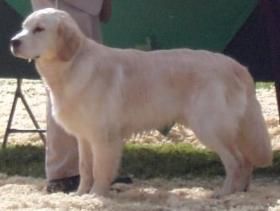 Golden Retriever American Kennel Club Official Standard Golden Retriever American Kennel Club Official Standard
General Appearance
A symmetrical, powerful, active dog, sound and well put together, not clumsy nor long in the leg, displaying a kindly expression and possessing a personality that is eager, alert and self-confident. Primarily a hunting dog, he should be shown in hard working condition. Overall appearance, balance, gait and purpose to be given more emphasis than any of his component parts. Faults--Any departure from the described ideal shall be considered faulty to the degree to which it interferes with the breed's purpose or is contrary to breed character.
Size, Proportion, Substance
Males 23-24 inches in height at withers; females 21 1⁄2-22 1⁄2 inches. Dogs up to one inch above or below standard size should be proportionately penalized. Deviation in height of more than one inch from the standard shall disqualify. Length from breastbone to point of buttocks slightly greater than height at withers in ratio of 12:11. Weight for dogs 65-75 pounds; bitches 55-65 pounds.
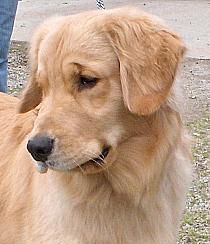 Head Head
Broad in skull, slightly arched laterally and longitudinally without prominence of frontal bones (forehead) or occipital bones. Stop well defined but not abrupt. Foreface deep and wide, nearly as long as skull. Muzzle straight in profile, blending smooth and strongly into skull; when viewed in profile or from above, slightly deeper and wider at stop than at tip. No heaviness in flews. Removal of whiskers is permitted but not preferred. Eyes friendly and intelligent in expression, medium large with dark, close-fitting rims, set well apart and reasonably deep in sockets. Color preferably dark brown; medium brown acceptable. Slant eyes and narrow, triangular eyes detract from correct expression and are to be faulted. No white or haw visible when looking straight ahead. Dogs showing evidence of functional abnormality of eyelids or eyelashes (such as, but not limited to, trichiasis, entropion, ectropion, or distichiasis) are to be excused from the ring. Ears rather short with front edge attached well behind and just above the eye and falling close to cheek. When pulled forward, tip of ear should just cover the eye. Low, hound-like ear set to be faulted. Nose black or brownish black, though fading to a lighter shade in cold weather not serious. Pink nose or one seriously lacking in pigmentation to be faulted. Teeth scissors bite, in which the outer side of the lower incisors touches the inner side of the upper incisors. Undershot or overshot bite is a disqualification. Misalignment of teeth (irregular placement of incisors) or a level bite (incisors meet each other edge to edge) is undesirable, but not to be confused with undershot or overshot. Full dentition. Obvious gaps are serious faults.
Neck, Topline, Body
Neck medium long, merging gradually into well laid back shoulders, giving sturdy, muscular appearance. No throatiness. Backline strong and level from withers to slightly sloping croup, whether standing or moving. Sloping backline, roach or sway back, flat or steep croup to be faulted. Body well balanced, short coupled, deep through the chest. Chest between forelegs at least as wide as a man's closed hand including thumb, with well developed forechest. Brisket extends to elbow. Ribs long and well sprung but not barrel shaped, extending well towards hindquarters. Loin short, muscular, wide and deep, with very little tuck-up. Slab-sidedness, narrow chest, lack of depth in brisket, excessive tuck-up to be faulted. Tail well set on, thick and muscular at the base, following the natural line of the croup. Tail bones extend to, but not below, the point of hock. Carried with merry action, level or with some moderate upward curve; never curled over back nor between legs.
Forequarters
Muscular, well coordinated with hindquarters and capable of free movement. Shoulder blades long and well laid back with upper tips fairly close together at withers. Upper arms appear about the same length as the blades, setting the elbows back beneath the upper tip of the blades, close to the ribs without looseness. Legs, viewed from the front, straight with good bone, but not to the point of coarseness. Pasterns short and strong, sloping slightly with no suggestion of weakness. Dewclaws on forelegs may be removed, but are normally left on. Feet medium size, round, compact, and well knuckled, with thick pads. Excess hair may be trimmed to show natural size and contour. Splayed or hare feet to be faulted.
Hindquarters
Broad and strongly muscled. Profile of croup slopes slightly; the pelvic bone slopes at a slightly greater angle (approximately 30 degrees from horizontal). In a natural stance, the femur joins the pelvis at approximately a 90-degree angle; stifles well bent; hocks well let down with short, strong rear pasterns. Feet as in front. Legs straight when viewed from rear. Cow-hocks, spread hocks, and sickle hocks to be faulted.
Coat
Dense and water-repellent with good undercoat. Outer coat firm and resilient, neither coarse nor silky, lying close to body; may be straight or wavy. Untrimmed natural ruff; moderate feathering on back of forelegs and on underbody; heavier feathering on front of neck, back of thighs and underside of tail. Coat on head, paws, and front of legs is short and even. Excessive length, open coats, and limp, soft coats are very undesirable. Feet may be trimmed and stray hairs neatened, but the natural appearance of coat or outline should not be altered by cutting or clipping.
Color
Rich, lustrous golden of various shades. Feathering may be lighter than rest of coat. With the exception of graying or whitening of face or body due to age, any white marking, other than a few white hairs on the chest, should be penalized according to its extent. Allowable light shadings are not to be confused with white markings. Predominant body color which is either extremely pale or extremely dark is undesirable. Some latitude should be given to the light puppy whose coloring shows promise of deepening with maturity. Any noticeable area of black or other off-color hair is a serious fault.
Gait
When trotting, gait is free, smooth, powerful and well coordinated, showing good reach. Viewed from any position, legs turn neither in nor out, nor do feet cross or interfere with each other. As speed increases, feet tend to converge toward center line of balance. It is recommended that dogs be shown on a loose lead to reflect true gait.
Temperament
Friendly, reliable, and trustworthy. Quarrelsomeness or hostility towards other dogs or people in normal situations, or an unwarranted show of timidity or nervousness, is not in keeping with Golden Retriever character. Such actions should be penalized according to their significance.
Disqualifications
Deviation in height of more than one inch from standard either way.
Undershot or overshot bite.

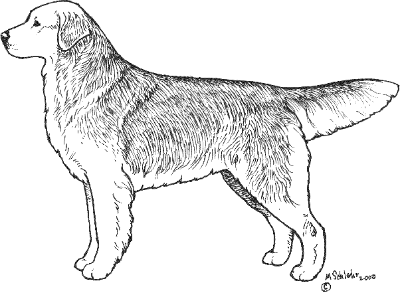 General Appearance: A symmetrical, powerful, active dog, sound and well put together, not clumsy or long in the leg, displaying a kindly expression and possessing a personality that is eager, alert and self-confident. Primarily a hunting dog, he should be shown in hard working condition. Over-all appearance, balance, gait and purpose to be given more emphasis than any of his component parts.Commentary: The general appearance section captures the essence of the Golden Retriever as a dog of moderation and as a true sporting dog. To assess overall appearance it may be useful for judges to study a silhouette of the breed and create a mental picture of the correct outline of the Golden Retriever. An outline, without influence of coat colour, animation, handling or grooming, allows one to assess overall proportion, the head properties in profile, the breadth and balance of the fore and hind quarters, length of neck, level topline, proper croup and tail set and carriage. The correct blending of all these properties creates the overall balance and harmony required in the Golden Retriever and exemplifies the phrase "well put together".Often seen as the glamour dog of the sporting group, sometimes style has been placed over the substance of the standard. When assessing the breed, it is important to remember the Golden Retriever consists of more than coat and attitude. The words "cute" and "pretty" do not appear in the standard. There is nothing more attractive, however, than a sound, athletic well put together dog in prime condition. The Golden Retriever should appear athletic, agile, and supple with the strength and stamina to stand a day’s work in the field. Muscles should be firm and developed without being overdone, a picture of a conditioned athlete. The Golden Retriever is a versatile breed capable of many functions, all of which benefit from a moderately sized dog with correct structure, temperament and size. General Appearance: A symmetrical, powerful, active dog, sound and well put together, not clumsy or long in the leg, displaying a kindly expression and possessing a personality that is eager, alert and self-confident. Primarily a hunting dog, he should be shown in hard working condition. Over-all appearance, balance, gait and purpose to be given more emphasis than any of his component parts.Commentary: The general appearance section captures the essence of the Golden Retriever as a dog of moderation and as a true sporting dog. To assess overall appearance it may be useful for judges to study a silhouette of the breed and create a mental picture of the correct outline of the Golden Retriever. An outline, without influence of coat colour, animation, handling or grooming, allows one to assess overall proportion, the head properties in profile, the breadth and balance of the fore and hind quarters, length of neck, level topline, proper croup and tail set and carriage. The correct blending of all these properties creates the overall balance and harmony required in the Golden Retriever and exemplifies the phrase "well put together".Often seen as the glamour dog of the sporting group, sometimes style has been placed over the substance of the standard. When assessing the breed, it is important to remember the Golden Retriever consists of more than coat and attitude. The words "cute" and "pretty" do not appear in the standard. There is nothing more attractive, however, than a sound, athletic well put together dog in prime condition. The Golden Retriever should appear athletic, agile, and supple with the strength and stamina to stand a day’s work in the field. Muscles should be firm and developed without being overdone, a picture of a conditioned athlete. The Golden Retriever is a versatile breed capable of many functions, all of which benefit from a moderately sized dog with correct structure, temperament and size.
Proportion: The Golden Retriever is a "normal" canine type with a standard canine structure.
Head: Length of muzzle approximately equals the length of skull.Height: The distance from withers to elbow should approximately equal the distance from elbow to ground.
Height to Length ratio: approximately 11:12 when measured from withers to ground and from prosternum to pinbone.
Bone lengths: The scapula and humerus should be approximately equal in length, as should the pelvis, femur and tibia/fibula in the rear. As a guideline for the eye, the angulation between the scapula and humerus and pelvis and femur should approach ninety degrees.
A vertical line drawn from the pinbone to the ground should drop through the nails of the rear foot.
A dog with the correct proportions and angulation can thereby achieve static balance.
Temperament: Friendly, reliable, trustworthy. Hostility or aggressiveness towards other dogs or people, undue timidity or nervousness in normal situations is not in keeping with the character of the Golden Retriever. Dogs displaying poor temperament should be excused from the ring.
Commentary: As described in the general appearance section, the Golden Retriever should be eager, alert and self-confident. Any dog whose behaviour, carriage or body language indicates hyperactivity, aggressiveness, lack of confidence or shyness is not displaying true Golden character. Ears pinned to the side of the head, whites of the eyes showing, a stiff upright tail, a crouching or slinking posture in the stack or on the move could be indicative of incorrect temperament. The Golden Retriever should be friendly, responsive to people, receptive to other dogs and adaptable to most situations.
Size:Males 23-24 inches (58-62 cm.) in height at withers; females, 21 ½- 22 ½ inches (55-57 cm.). Length from breastbone to buttocks slightly greater than height at withers in ratio of 12:11. Weight for dogs, 65-75 lb. (29-34 kg); bitches, 60-70 lb. (27-32 kg.)
Commentary: With an emphasis on moderation, preference should be given to those dogs falling within the desirable size limits. Those falling outside the recommended sizes should be faulted to the degree that size might interfere with their efficiency as a working retriever. Many Goldens today are in excess of the suggested weights and coarse, oversized dogs should be considered seriously faulty. Please note that there is no size exemption for puppies concerning the breed disqualification for size. Often Golden Retriever puppies do not meet size requirements until after they are six months of age and therefore should not be shown until they are of legal size.
The 12:11 ratio of proportion indicated in the standard indicates a dog only slightly off square. Correct proportions are important in maintaining the correct outline and functionality of the breed. A dog which is too long in body and too short on leg cannot function as an efficient retriever. The measurement of withers to elbow should be approximately equal to the measurement from elbow to ground. Structure of the fore and hind quarters should reflect nearly equal bone lengths of scapula and humerus, pelvis and femur, to present a picture of correct balance.
Coat and Colour: Dense and water repellent with good undercoat. Texture not as hard as that of a short-haired dog nor silky as that of a setter. Lies flat against body and may be straight or wavy. Moderate feathering on back of forelegs and heavier feathering on front of neck, back of thighs and underside of tail. Feathering may be lighter than rest of coat. Excessive length, open coats or limp, soft coats are undesirable. The natural appearance of coat or outline should not be altered by cutting or clipping, other than the trimming of the feet and neatening of stray hairs. Colour lustrous golden of various shades. A few white hairs on chest permissible but not desirable. Further white markings to be faulted except for greying or whitening of the face or body due to age. Any noticeable area of black or other off-colour hair to be faulted.
Commentary: The coat should provide a protective, waterproof jacket, with a dense undercoat. The Golden Retriever should be presented as a natural hunting breed, therefore excessive grooming and/or trimming and sculpting is not appropriate for the breed. A Golden with a correct coat will require a minimum of grooming. Excessive coat and furnishings are not in keeping with the function of the Golden as a hunting dog. Modern grooming techniques often create the appearance of an incorrect open coat. Blow-drying and the application of various grooming products can cause the coat to stand out from the body in an attempt to create an illusion of more bone or substance.
The coat should lie flat against the body and have a firm texture to allow for the shedding of water, protection from debris in the field and the quick drying of the coat when retrieving. Soft, limp or silky coats are too absorbent and lack the protective qualities of a correct coat. Please note that a wavy coat, especially noticeable along the backline and rear of the dog, is perfectly acceptable and is often reflective of correct texture in the coat.
The acceptable range of colour in the Golden Retriever is broad. While a medium gold is always correct, coat colour can range from cream to a darker coppery gold. Any dogs within this range of colour should be considered equally, based on their merits, including balance, head type, movement and structure. In Canada, there is a broader range of acceptable colouring than allowed in the AKC standard. Many of the early Goldens were very rich coloured and these rich colours are still present in the breed. Cream was added to the English standard in 1936 due to the growing popularity of the colour and its place within the early development of the breed. This range of colours and shadings is perfectly acceptable and is a pleasant variation within the breed. Generally the feathering, underpants and tail plume are lighter in colour than the body coat. A Golden’s body colour tends to darken over several years to the colour of the ears, so ear colour should be considered in an otherwise very pale puppy. A flat tan or plain brown coloured dog, (i.e. not lustrous or displaying a golden hue) is to be faulted.
Goldens grey at various ages, often as early as five or six years, commencing at the muzzle and often progressing throughout the coat with passing years. This should not be penalized in a quality exhibit. Noticeable areas of black or any other off colour in the coat are major faults.
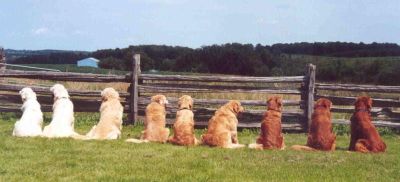 This photo illustrates the extreme limits of the acceptable colour range for the Golden Retriever. This photo illustrates the extreme limits of the acceptable colour range for the Golden Retriever.
"Lustrous golden of various shades" this photo illustrates the broad range of acceptable colour in the Golden Retriever.
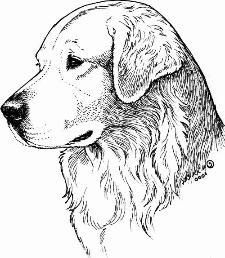 Head: Broad in skull, slightly arched laterally and longitudinally without prominence of frontal or occiput bones. Good stop. Head: Broad in skull, slightly arched laterally and longitudinally without prominence of frontal or occiput bones. Good stop.
Foreface: deep and wide, nearly as long as skull.
Muzzle: when viewed in profile, slightly deeper at stop than at tip; when viewed from above, slightly wider at stop than at tip. No heaviness in flews. Removal of whiskers for show purposes optional. Commentary: The head is one of the hallmarks of the breed. It should be clean-cut and chiselled with a warm, friendly, gentle expression. Expression, which is made up of eye shape and colour, skull structure, ear placement, shading in the coat, and pigment is very important in this breed. While the expression is best determined with the ears alert, the conformation of the head should also be examined with the ears at rest and hanging naturally. There should be no wrinkling on the forehead. The stop should be a marked, short rise between the nearly parallel levels of the muzzle, which is straight in profile, and the slightly arched back skull. The stop should not be indented or abrupt as in the American Cocker Spaniel or so minimal as to resemble a "ski-slope".
The muzzle should be approximately equal in length to the back skull and blend well into the skull. A strong muzzle with good breadth and depth and a strong under jaw is important in carrying heavy game. Lips should not hang loosely and dogs should be examined to ensure the proper jaw structure is in place and not be misled by overhanging lips. Heavy flews can collect debris and make it difficult to correctly pick up and carry game.
Whiskers are considered as an important part of the dog’s sensory abilities and on the versatile golden retriever they are generally not removed for show purposes. Nose: black or dark brown, though lighter shade in cold weather not serious.
Commentary: The nose, eye rims and lips should be dark, preferably black with flesh coloured pigmentation to be seriously faulted. A dudley nose, one without pigmentation, should be seriously faulted. Often the central portion of the nose pigment will fade during the winter months. As long as a darker pigment border exists around the edges of the nose, this is not to be considered a dudley nose and is not a serious concern. A dog with unfading, naturally dark pigment is to be preferred. A liver nose is not acceptable. Teeth: scissors bite with lower incisors touching inside of upper incisors. Full dentition. Obvious gaps created by missing teeth to be faulted.
Commentary: Overshot and undershot bites are a disqualification in the breed. Full dentition is important to strong jaw structure that is necessary in a hunting breed that must retrieve both waterfowl and upland game. It is not necessary to count the teeth. The appearance in the mouth should be one of complete dentition without obvious gaps. The tooth most often missing is the lower fourth premolar. Occasionally extra teeth (generally incisors) are seen.
There is occasionally a misalignment of the lower central incisors (dropped incisors) and this should be penalized only to the degree of misalignment and the resulting excessive wear to teeth. A level bite is not desirable due to the excessive wear caused by the teeth meeting edge to edge. Judges should examine the mouth carefully for correct bite and occlusion of the side teeth.
Head (continued): Eyes: friendly and intelligent, medium large with dark, close-fitting rims, set well apart and reasonably deep in sockets. Colour preferably dark brown, never lighter than colour of coat. No white or haw visible when looking straight ahead. Dogs showing evidence of a functional abnormality of the eyelids or eyelashes (Such as, but not limited to, trichiasis, entropion, ectropion or distichiasis) are to be excused from the ring.
Commentary: Light eyes give a harsh, atypical look while round eyes, small triangular eyes or a slanted eye set, all detract from proper expression. The eyes should be more oval shaped and dark but not black or expressionless, and should be set relatively wide apart. Close-fitting rims are an important feature in a dog working in the field and subject to debris collecting in a loose-fitting lid. While we are not asking judges to diagnose problem eye conditions, which can only be determined by a veterinary ophthalmologist, dogs which show excessive tearing or irritation of the eye (a functional abnormality), must be excused from the ring. The listing of sample eye disorders is to make people aware that such conditions are not desirable in the breed if they affect the dog’s ability to function in a normal manner. Ears: rather short, hanging flat against head with rounded tips slightly below jaw. Forward edge attached well behind and just above eye with rear edge slightly below eye.
Commentary: The ear leather should be soft, flexible and well covered with hair. The ear should fall close to the head when at rest. The correctly sized ear should reach to the inner corner of the same-side eye.
Greying of the face due to aging, as seen in this lovely veteran, should not to be penalized. The eager, alert expression of the Golden Retriever is best determined with the ears up, but the conformation of the head should also be examined with the dog relaxed and the ears naturally at rest.
The Golden Retriever should be a dog of moderation, sound and well put together. Overall appearance, balance, gait and purpose must take priority over any component parts. To function as a powerful, active, athletic, sporting dog, the Golden Retriever must exemplify moderation in size, bone and coat.
Neck: Medium long, sloping well back into shoulders, giving sturdy muscular appearance with untrimmed natural ruff. No throatiness.
Commentary: A strong, muscular neck is critical to the retrieving and carrying of heavy game. The ruff is a natural frame for the head and should not be noticeably stripped or cut to destroy the natural appearance of the dog. A hands on examination will reveal if the dog has the correct length of neck under the coat. The neck should show some arch or crest between the head and the set on of the shoulders. An ewe-neck, which joins the shoulders at an abrupt right angle, or an excessively long neck, which lacks muscular strength and stamina for carrying game, are to be faulted.
Forequarters:Forequarters muscular, well co-ordinated with hindquarters and capable of free movement. Shoulder blades wide, long and well laid back, showing angulation with upper arm of approximately 90 degrees. Shoulder blade and upper arm (humerus) should be approximately equal in length, setting close fitting elbows back beneath the upper tip of the shoulder blades. Legs straight with good bone. Pastern short and strong, sloping slightly forward with no suggestion of weakness.
Commentary: Evaluation of the front assembly requires a careful "hands on" assessment. As a guideline for the judge’s eye, the shoulder layback should approach 45 degrees. The recommended guideline of 90-degree angulation of the shoulder blade and humerus should also be seen between the pelvis and the femur in the rear assembly for correct balance to occur. The distance from the ground to the elbow should be approximately one-half the height at the withers. The Golden should never be long in leg, nor appear clumsy or too close to the ground due to insufficient length of leg. The function of the Golden as a working retriever must always be kept in mind.
Straight front angulation and short upper arms have become significant problems in the breed. Poor front assemblies are reflected in a short, choppy inefficient stride and other gait problems when the front assembly out of balance with the rear assembly. Straight shoulders are often combined with a short and/or upright neck and lack of forechest.
Body:Topline level from withers to croup, whether standing or moving. Well balanced, short coupled, deep through the heart. Chest at least as wide as a man’s hand, including thumb. Brisket extends to elbows. Ribs long and well sprung but not barrel shaped, extending well to rear of body. Loin short, muscular, wide and deep, with very little tuck-up. Croup slopes gently.
Commentary: The back line must be firm and level. Body length should come from a well-sprung rib cage extending back to a short wide loin, not from a short rib cage with a long loin. Judges must evaluate the forequarters and body with their hands, as a dense coat and heavy ruff can mask the lack of forechest, shallow brisket or lack of rib-spring. The prosternum should be prominent with good width between the front legs and depth of chest reaching to the elbows. The area of the chest beneath the prosternum should be well filled when examined by hand.
Hindquarters:Well bent stifles (angulation between femur and pelvis approximately 90 degrees) with hocks well let down. Legs straight when viewed from rear. Feet medium size, round and compact with thick pads. Excessive hair may be trimmed to show natural size and contour.
Commentary: The rear quarters provide the power and drive but must be coordinated with the front to be efficient and balanced. The femur and lower thigh (tibia/fibula) should be approximately equal in length. A longer lower thigh can create over-angulation and destroy balance. The thighs should be well muscled when examined. When the dog is standing naturally, the hock should fall slightly behind a line drawn from the point of the buttock to the ground.
Correct feet are important to a hunting dog. Flat, hare or splayed feet without thick pads and well-arched toes must be faulted. Nails should be cut short but not so short as to be non- functional.
These feet are medium-sized, round, well-arched and compact, trimmed to show their natural outline. Note the short, slightly sloping pastern and well let down hock.
Tail:Well set on, neither too high nor too low, following natural line of croup. Length extends to hock. Carried with merry action with some upward curve but never curled over back or between legs.
Commentary: The tail acts as a rudder in the swimming dog and as an instrument of balance in the moving dog, therefore its set and carriage are important. A high or vertical tail carriage not only destroys the correct profile of the breed but prohibits the proper functioning of the tail both in the water and when moving. The tail should be carried level with the topline or with some upward curve, but should never leave the croup at an abrupt angle.
Gait:When trotting, gait is free, smooth, powerful, and well co-ordinated. Viewed from front or rear, legs turn neither in nor out, nor do feet cross or interfere with each other. Increased speed causes tendency of feet to converge toward centreline of gravity.
Commentary: Correct, efficient, ground-covering movement is an integral part of Golden Retriever type and function. While it appears stylish to have a "heads up" attitude when gaiting, a high head carriage, whether caused by incorrect structure or improper handling, can reflect or cause a lack of reach in the front. A dog with correct reach and drive and smooth side gait will often lower its head and neck to accomplish this efficient movement and should not be penalized. Lowering of the head assists the dog in maintaining a correct centre of gravity while in motion, or "kinetic balance".
Dogs should be moved on a loose lead, to allow for a natural head carriage, and at a moderate speed. The gait should be smooth and well coordinated, which requires good conditioning and muscling in addition to correct structure. The topline should remain level when gaiting. A rolling or bouncing topline are indicative of incorrect structure or poor condition. At maximum extension, the feet should clear the ground with just enough clearance to change stride efficiently. Padding and excessive rear kick back are not efficient, energy conserving movements and one should not be deceived into thinking that such movement represents good reach and drive.
Faults:White markings beyond a few hairs on chest. Dudley nose (pink without pigmentation). Low, hound-like ear-set. Slab-sideness, narrow chest, lack of depth in brisket, excessive tuck-up, roach or sway back. Cowhocks and sickle hocks. Open or splayed feet.Disqualifications:Deviations in height of more than 1 inch (3 cm) from standard either way.
Undershot or overshot jaws. This condition not to be confused with misalignment of teeth.
Trichiasis (abnormal position or direction of eyelashes)

General Appearance Symmetrical, balanced, active, powerful, level mover; sound with kindly expression.
Characteristics Biddable, intelligent and possessing natural working ability.
Temperament Kindly, friendly and confident.
Head and Skull Balanced and well chiseled, skull broad without coarseness; well set on neck, muzzle powerful, wide and deep. Length of foreface approximately equals length from well defined stop to occiput. Nose preferably black.
Eyes Dark brown, set well apart, dark rims.
Mouth Jaws strong, with a perfect, regular and complete scissor bite, i.e. upper teeth closely overlapping lower teeth and set square to the jaws.
Neck Good length, clean and muscular.
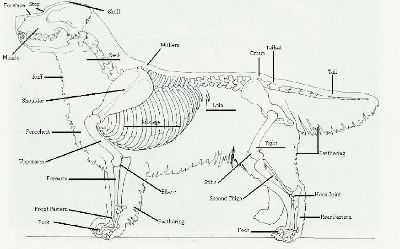 Forequarters Forelegs straight with good bone, shoulders well laid back, long in blade with upper arm of equal length placing legs well under body. Elbows close fitting. Forequarters Forelegs straight with good bone, shoulders well laid back, long in blade with upper arm of equal length placing legs well under body. Elbows close fitting.
Body Balanced, short coupled, deep through heart. Ribs deep, well sprung. Level topline.
Hindquarters Loin and legs strong and muscular, good second thighs, well bent stifles. Hocks well let down, straight when viewed from rear, neither turning in nor out. Cow-hocks highly undesirable.
Feet Round and cat-like.
Tail Set on and carried level with back, reaching to hocks, without curl at tip.
Gait / Movement Powerful with good drive. Straight and true in front and rear. Stride long and free with no sign of hackney action in front.
Coat Flat or wavy with good feathering, dense water-resisting undercoat.
Colour Any shade of gold or cream, neither red nor mahogany. A few white hairs on chest only permissible. IMPORTANT NOTE: From 2000, only Cream, Gold or Golden will be accepted by the KC on registrations.
Size Height at withers: dogs; 56-61 cms (22-24ins) bitches: 51-56cms (20-22ins).
Faults Any departure from the foregoing points should be considered a fault and the seriousness with which the faults should be regarded should be in exact proportion to its degree.
Note Male animals should have two apparently normal testicles fully descended into the scrotum.

FCI-Standard N° 111 / 29. 01. 1999/ GB
ORIGIN : Great Britain.
DATE OF PUBLICATION OF THE ORIGINAL VALID STANDARD : 24.06.1987.
UTILIZATION : Gundog.
CLASSIFICATION F.C.I. : Group 8 Retrievers, Flushing Dogs, Water Dogs.
Section 1 Retrievers.
With working trial.
GENERAL APPEARANCE : Symmetrical, balanced, active, powerful, level mover; sound with kindly expression.
BEHAVIOUR / TEMPERAMENT : Biddable, intelligent and possessing natural working ability; kindly, friendly and confident.
HEAD : Balanced and well chiselled.
CRANIAL REGION :
Skull : Broad without coarseness; well set on neck.
Stop : Well defined.
FACIAL REGION :
Nose : Preferably black.
Muzzle : Powerful, wide and deep. Length of foreface approximately equals length from stop to occiput.
Jaws/Teeth : Jaws strong, with a perfect, regular and complete scissor bite, i.e. upper teeth closely overlapping lower teeth and set square to the jaws.
Eyes : Dark brown, set well apart, dark rims.
Ears : Moderate size, set on approximate level with eyes.
NECK : Good length, clean and muscular.
BODY : Balanced.
Back : Level topline.
Loins : Strong, muscular, short-coupled.
Chest : Deep through heart. Ribs deep, well sprung.
TAIL : Set on and carried level with back, reaching to hocks, without curl at tip.
LIMBS
FOREQUARTERS : Forelegs straight with good bone.
Shoulders : Well laid back, long in blade.
Upper arm : Of equal length as the shoulder blade, placing legs well under body.
Elbows : Close fitting.
HINDQUARTERS : Hindlegs strong and muscular.
Stifles : Well bent.
Second thigh : Good.
Hocks : Well let down, straight when viewed from rear, neither turning in nor out. Cow-hocks highly undesirable.
FEET : Round and cat-like.
GAIT / MOVEMENT : Powerful with good drive. Straight and true in front and rear. Stride long and free with no sign of hackney action in front.
COAT
HAIR : Flat or wavy with good feathering, dense water-resisting undercoat.
COLOUR : Any shade of gold or cream, neither red nor mahogany. A few white hairs on chest only, permissible.
SIZE :
Height at withers : Dogs 56 - 61 cm (22-24 ins);
Bitches 51 - 56 cm (20-22 ins).
FAULTS : Any departure from the foregoing points should be considered a fault and the seriousness with which the fault should be regarded should be in exact proportion to its degree and its effect upon the health and welfare of the dog.
Any dog clearly showing physical or behavioural abnormalities shall be disqualified.
N.B. : Male animals should have two apparently normal testicles fully descended into the scrotum
ALL CONTENT, COPY, AND PICTURES ON THIS SITE IS COPYRIGHTED AND MAY NOT BE USED FOR ANY REASON WITHOUT EXPRESS WRITTEN PERMISSION. (c) 2004 PROMISE KENNELS
| |